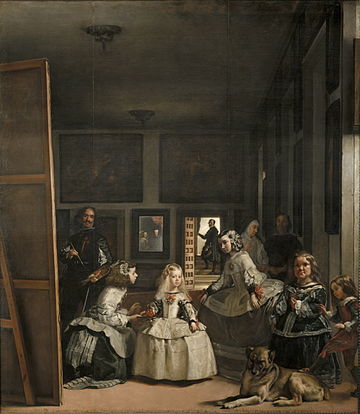
Las Meninas by Diego Velázquez was completed in 1656. This painting is particularly interesting because the setting is in the artist’s own studio in the palace of King Philip IV of Spain. The title means “the ladies-in-waiting” and the painting depicts the daughter of the king, Infanta Margarita Theresa, being attended to by the eponymous ladies-in-waiting. To the right are two dwarfs. Behind them is the princesses’ nurse and a body guard. The artist himself is at the far left. And lurking in the background is Don Jose Nieto Velázquez, an attendant to the queen. The king and queen themselves can be seen reflected in the mirror.
This painting is a good example of the influence of royalty on arts that persisted into the Baroque period. Velázquez stayed at the royal palace in Spain and painted many portraits of the royal family. Although the power of the merchant class and their demand for art was growing, royalty was still very important for the arts. Because Velázquez was patronized by the king he was secure enough to focus on honing his art skills, resulting in him becoming known as the greatest Spanish painter of the Baroque era. His skill can be seen in the portrait. The reflection of the king and queen is faint enough to be realistic but skillfully painted enough that it seems like a real reflection. The fact that he included the king and queen shows how important they were. Even though the main subject of the painting is not them, they still hold a presence in the art, because it is their support of him that enabled this portrait to exist in the first place. By painting himself into the painting, Velázquez makes himself a symbol of the relationship between royalty and art. The princess is in the center of the painting and dressed and white and lit by light, making her a symbol of purity and goodness. Through such symbolism, Velázquez portrays the royals as good people because they support the arts.
I like this painting because it seems very realistic, as if we have just stumbled in the room and the scene is enfolding in front of us. Some of the subjects look right at us, inviting us to join in while others look away, maintaining the feel that this a real event. I also love the small details, like the mirror reflecting the king and queen, the mysterious man in the back,and the disgruntled look on the dog’s face as the dwarfs prod it. The way that light is used in the picture, coming from several directions and drawing our attention to the princess, is interesting.
Kahr, Madlyn Millner. “Velázquez and Las Meninas.” The Art Bulletin, vol. 57, no. 2,June 1975, pp. 225-46. JSTOR, doi:10.2307/3049372. Accessed 26 Sept. 2016. http://www.jstor.org/stable/3049372
“Las Meninas.” Museo del Prado. Accessed 26 Sept. 2016. https://www.museodelprado.es/en/the-collection/art-work/las-meninas/9fdc7800-9ade-48b0-ab8b-edee94ea877f
 Although Michelangelo is well known for his paintings, he was also an accomplished sculptor. He finished his marble sculpture, David, in 1504 and it was displayed in a public square in the city of Florence. It was originally meant to be placed on the roof of the Florence Cathedral but at several tons it was too heavy.
Although Michelangelo is well known for his paintings, he was also an accomplished sculptor. He finished his marble sculpture, David, in 1504 and it was displayed in a public square in the city of Florence. It was originally meant to be placed on the roof of the Florence Cathedral but at several tons it was too heavy.